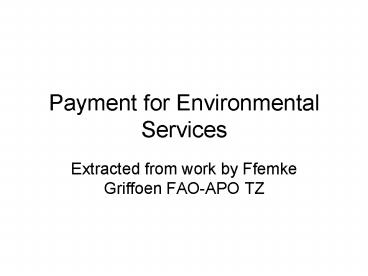Payment for Environmental Services PowerPoint PPT Presentation
Title: Payment for Environmental Services
1
Payment for Environmental Services
- Extracted from work by Ffemke Griffoen FAO-APO TZ
2
- Examples of valuation of ecosystem goods and
services - Valuation of ecosystem goods and services is
gradually getting more attention in Tanzania.
Examples of valuation mentioned here are - The contribution of natural resources to economic
growth e.g. revenue derived from export of timber
and fish. - Values derived from market prices of products
that use ecosystem goods, e.g. the value of a
volume of water based on the price for paddy rice
and hydropower services
3
Examples for PES
- Planned and starting initiatives with Payment for
Environmental Services e.g. greenhouse gas
credits, and payment by water users for catchment
protection
4
Contribution of Natural Resources to Economic
Growth
- The World Bank, through COWI, has made an
analysis on the contribution of Tanzanias
natural resources to growth and reduction of
poverty for the Country Economic Memorandum
5
- Forestry contributes officially 2-3 to GDP and
a 10-15 share of export earnings. Estimates
taking unaccounted services and non-industrial
forestry into account are accounting for a value
of 10-15 of GDP. - Forests provide around 75 of building materials
and 100 of indigenous medicinal plants and
supplementary food products. 95 of Tanzanias
energy consumption is wood fuel based, which
includes major inputs factors into rural
industries such as for example tobacco curing and
fish smoking. - The value of carbon sequestration services
provided by Tanzanian forests is estimated to be
between US 700 and 1,500 per ha.
6
- Tanzanias Fisheries sector has grown at a rate
of 6 to 7 annually since 2000. In 2004 revenue
collection from Fisheries amounted to Tsh. 9.7
billion. This represents roughly a 50 increase
from revenue collected in 2001/02. About 80 of
revenue is coming from freshwater fisheries
(2003).
7
Rough estimated value added per m3 water in
different uses
8
money (Tsh per year) households derived from
harvesting of aquatic resources (including value
added in processing), averaged across user and
non-user households
9
Carbon Sequestration Credits
- Present models show that the trees planted
through the pilot program Phase III (in 4
countries) should achieve between 500,000 tons
and 3,000,000 tons of CO2 sequestration.
10
PES for Catchment Conservation
- As catchment forests are decreasing, their
conservation capacity for water is reduced and
water supply for towns with increasing population
faces critical shortages. - At the same time, many poor people are dependent
on forest biodiversity for wood-fuel, food,
honey, medicines, building poles, timber, animal
fodder and farming. - Forest biodiversity needs to be maintained to
sustain essential environmental services such as
water supply, carbon sequestration, soil
conservation and wildlife habitat.
11
PES Cont
- Funds currently allocated to forest conservation
are inadequate - Given the state of the catchment and their
importance to water availability. - Incentives packages and water users contribution
are crucial. - Payment for water as an environmental service is
a potential mechanism
12
PES Cont
- In a proposal Making Payments for Environmental
Services Work for Nature and People, WWF, CARE
and IIED propose carefully constructed Payments
for Environmental Services (PES) in the Uluguru
Mountains (TZ)
13
PES Cont
- This PES, especially with regards to water, have
the potential to shift the incentives-structure
of local people and authorities from damaging to
preserving forests in the Uluguru Mountains - At the same time will be part of efforts that aim
at the promotion of environmental sustainability
that become fully integrated into poverty
reduction efforts.
14
The watershed services that would be sold
- 1. Soil/stream bank stabilization to ensure the
quality of downstream water, and - 2. Catchment forest conservation to improve the
reliability of water flows. - It is planned that at a later stage the
biodiversity conservation, carbon sequestration
services and aesthetics will also be sold as part
of a bundle of ecological services
15
Potential buyers of watershed services
- Cities of Dar es Salaam and Morogoro Urban Water
Authorities / Company. - Revenues raised from PES can be expected to
generate a substantial and sustainable impact on
local livelihoods especially through improved
land use/husbandry, agricultural and
horticultural productivity and organizing
communities into CBOs for obtaining
other/additional sources of incomes.
16
Conclusion
- PES in the Uluguru Mountains are likely to have
considerable conservation impact because they can
readily focus on upland communities that are
directly involved in the degradation of forest
assets and are positioned to regulate the use of
forest assets by themselves as well as others.

